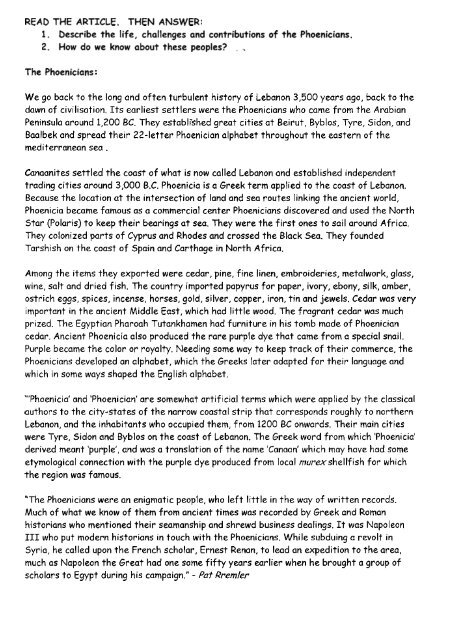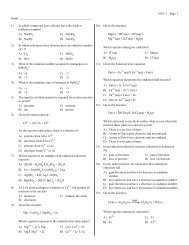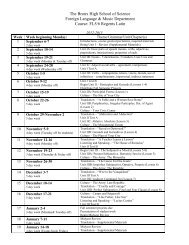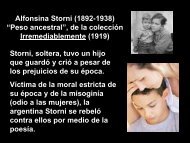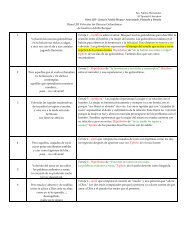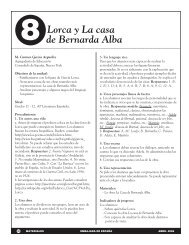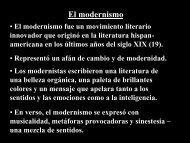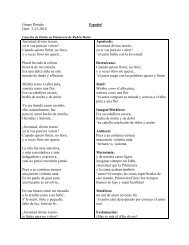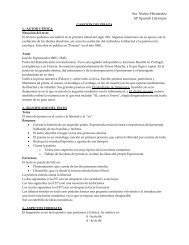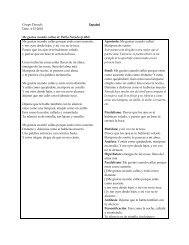Phoenicians.pdf
Phoenicians.pdf
Phoenicians.pdf
Create successful ePaper yourself
Turn your PDF publications into a flip-book with our unique Google optimized e-Paper software.
READ THE ARTICLE. THEN ANSWER:<br />
1. Describe the life, challenges and contributions of the <strong>Phoenicians</strong>.<br />
2. How do we know about these peoples? , .<br />
The <strong>Phoenicians</strong>:<br />
We go back to the long and often turbulent history of Lebanon 3,500 years ago, back to the<br />
dawn of civilisation. Its earliest settlers were the <strong>Phoenicians</strong> who came from the Arabian<br />
Peninsula around 1,200 BC. They established great cities at Beirut, Byblos, Tyre, Sidon, and<br />
Baalbek and spread their 22-letter Phoenician alphabet throughout the eastern of the<br />
mediterranean sea<br />
Canaanites settled the coast of what is now called Lebanon and established independent<br />
trading cities around 3,000 B.C. Phoenicia is a Greek term applied to the coast of Lebanon.<br />
Because the location at the intersection of land and sea routes linking the ancient world,<br />
Phoenicia became famous as a commercial center <strong>Phoenicians</strong> discovered and used the North<br />
Star (Polaris) to keep their bearings at sea. They were the first ones to sail around Africa.<br />
They colonized parts of Cyprus and Rhodes and crossed the Black Sea. They founded<br />
Tarshish on the coast of Spain and Carthage in North Africa.<br />
Among the items they exported were cedar, pine, fine linen, embroideries, metalwork, glass,<br />
wine, salt and dried fish. The country imported papyrus for paper, ivory, ebony, silk, amber,<br />
ostrich eggs, spices, incense, horses, gold, silver, copper, iron, tin and jewels. Cedar was very<br />
important in the ancient Middle East, which had little wood. The fragrant cedar was much<br />
prized. The Egyptian Pharoah Tutankhamen had furniture in his tomb made of Phoenician<br />
cedar. Ancient Phoenicia also produced the rare purple dye that came from a special snail.<br />
Purple became the color or royalty. Needing some way to keep track of their commerce, the<br />
<strong>Phoenicians</strong> developed an alphabet, which the Greeks later adapted for their language and<br />
which in some ways shaped the English alphabet.<br />
"'Phoenicia' and 'Phoenician' are somewhat artificial terms which were applied by the classical<br />
authors to the city-states of the narrow coastal strip that corresponds roughly to northern<br />
Lebanon, and the inhabitants who occupied them, from 1200 BC onwards. Their main cities<br />
were Tyre, Sidon and Byblos on the coast of Lebanon. The Greek word from which 'Phoenicia'<br />
derived meant 'purple', and was a translation of the name 'Canaan' which may have had some<br />
etymological connection with the purple dye produced from local murexshellfish for which<br />
the region was famous.<br />
"The <strong>Phoenicians</strong> were an enigmatic people, who left little in the way of written records.<br />
Much of what we know of them from ancient times was recorded by Greek and Roman<br />
historians who mentioned their seamanship and shrewd business dealings. It was Napoleon<br />
111 who put modern historians in touch with the <strong>Phoenicians</strong>. While subduing a revolt in<br />
Syria, he called upon the French scholar, Ernest Renan, to lead an expedition to the area,<br />
much as Napoleon the Great had one some fifty years earlier when he brought a group of<br />
scholars to Egypt during his campaign." - Pat Rremler
Because of Renan's interest in Semitic languages, he was particularly keen on investigating<br />
the site of Byblos. I n addition to being a major Phoenician port the name held linguistic<br />
implications. "Byblos" the Greek word for paprus,.lead to "biblion" or book, which lead to<br />
"bible." Renan was pursuing an Old Testament reference, "Gebel," which was the Semitic<br />
name for Byblos. The trail ultimately lead to nothing for Renan's linguistic research, but<br />
during the investigation he found several granite slabs covered with Egyptian hieroglyphs,<br />
and a bas relief which he believed to be the goddess Hathor. The relief was, in fact, Baalat-<br />
Gobal the Phoenician earth-mother goddess. -Pat Remler<br />
This find was the beginning of the rediscovery of ancient Phoenicia. Later more extensive<br />
excavations produced a series of semi-intact royal tombs that yielded a glimpse of<br />
Phoenician treasure, including vessels of gold, silver, and obsidian, sandals and breastplates<br />
of gold, and an array of royal paraphernalia. The most important find, however, was an<br />
inscription in the Phoenician alphabet on an elaborate sarcophagus: "This coffin was made by<br />
Ithobaal, the son of Ahiram, King of Byplos, as the eternal resting place for his father. If<br />
any ruler or governor or general attacks Byblos and touches this coffin, his sceptre will be<br />
broken ...." This discovery in 1922 touched off a wave of excavation in Byblos and a renewed<br />
interest in the origin of the <strong>Phoenicians</strong>.- Pat Remler.<br />
The <strong>Phoenicians</strong> called themselves Canaanites, and modern researchers tell us they were the<br />
descendants of two groups, the early Canaanites who inhabited the coast of Lebanon, and<br />
the Sea People who invaded Lebanon about 1200 B.C. The early Canaanites had a limited ship<br />
building technology, sailing only flat bottomed barges that hugged the shore. The invading<br />
Sea People, some of whom stayed on, introduced among other things, a much more<br />
sophisticated maritime technology. Thus their descendants, the <strong>Phoenicians</strong>, appeared on<br />
the scene with on established maritime tradition, and the technology to build ships with o<br />
keeled hull. This allowed them to sail the open seas, and as a result, the <strong>Phoenicians</strong><br />
developed a flourishing sea trade. They settled along the coast of Lebanon, in a loose<br />
federation of city states that were built on islands of rocky promontories which provided<br />
natural harbors for ship building and trade. The cities, Byblos, Tyre, Sidon, Arqad, studded<br />
the seacoast like jewels, and their wealth became legendary. At the height of their trading<br />
empire, they imported copper from Cyprus: linen from Egypt; ivory from India: tin from<br />
Spain: horses from Anatolla: and peacocks from Africa. They became famous for their<br />
highly prized purple dye extracted from the murex snail, and for the fine timber cut from<br />
their forests. - Pat Remler.<br />
Their major cultural contribution was their alphabet. It consisted of 22 consonants, and was<br />
the foundation of our English alphabet, and it was the core for Hebrew, Arobic, and Syriac<br />
script. - Pat Remler.<br />
"The <strong>Phoenicians</strong> did not suddenly arrive upon the historical scene as invaders or immigrants.<br />
They were Canaanites, and cannot be differentiated either ethnically or culturally from the<br />
general mass of Canaanites. They just happened to be the survivors of the havoc that<br />
overwhelmed the eastern Mediterranean at the start of the Iron Age around 1200 BC, with<br />
the onslaught of the Sea Peoples, the collapse of the Hittite empire, the disintegration of
Mycenaean power, and the destruction of the great coastal cities of Ugarit, Aradus and<br />
Sidon." - Magnus Magnusson, BC - The Archaeology of the Bible Lands<br />
"Phoenician ritual is illustrated by an alabaster statuette from Tutugi (Galera), near<br />
Granada in Spain. From its artistic style it must be eastern of the seventh or sixth century<br />
BC, but the tomb in which it was found was perhaps not earlier than the fourth. It<br />
represents Astarte seated on a throne flanked by sphinxes. She holds a large bowl<br />
outstretched under her breasts, which are pierced. This is clearly a miracle-working<br />
statuette, which at an appropriate time'in the cult ceremony enabled milk to flow through<br />
the breasts into the bowl from a hollow that would be filled through the head. Until the<br />
miracle was to happen the holes in the breasts were blocked with wax, or other material,<br />
removable by gentle heating." -Donald Harden, The <strong>Phoenicians</strong><br />
"'Phoenician' means 'red haired'. The <strong>Phoenicians</strong> and the Carthaginians expanded all across<br />
North Africa and western Europe. They pushed past the Straits of Gibraltar and founded<br />
the city of Gades (present day Cadiz) in Spain. While active in Spain, these<br />
Phoenician/Carthaginian descendants are called 'Celtiberians' by archaeologists. Later, some<br />
sailed away from Spain and colonized the British Isles, where they are simply called 'Celts'<br />
by archaeologists. I n their migrations throughout the Mediterranean, these Celts picked up<br />
a number of different languages and alphabets. These languages and writing systems were in<br />
use by different Celtic groups at different times. Memories of some of these scripts were<br />
retained up until the medieval period in Ireland. The Book of Ballymote, believed to have<br />
been composed obout 1200 A.D., gives an alphabet, described as 'African'. Until recently,<br />
scholars considered that this 'African' script was some sort of cryptic monkish secret<br />
alphabet, or maybe just gibberish, but since 1960 this alphabet has been shown to be an<br />
actual ancient North African one in use obout 1000 B.C." [Fell, America B.C] - Michael<br />
Bradley, Holy Grail Across the Atlantic<br />
"Mention ... of both the gens Hiernorurn and the insula Albionum suggest that Himilco [c. 425<br />
BC] did not stop at Brittany - the Oestrymnian promontory as he calls it - but passed on<br />
across the channel, and in effect led the way for Carthage to take part in the Cornish tin<br />
trade, which we may assume was already being exploited by Mediterranean traders via the<br />
overland route. There is, unfortunately, no direct archaeological evidence of Phoenician<br />
contacts with Britain at this period to support the Himilco story, though a number of Iron<br />
Age finds in Cornwall indicates Iberian contacts." - Donald Harden, The <strong>Phoenicians</strong><br />
"Following the breakdown of Aegean civilization, ca. 1200 B.C., central Europe developed a<br />
distinctive Late Bronze Age culture from which the Celts emerged. By about 700 B.C. the<br />
Hallstatt culture - the culture of the Celts - covered much of western Europe. It lasted into<br />
the fifth century B.C." - Barry Cunliffe, The Celtic World<br />
The <strong>Phoenicians</strong> were skilled artisans noted for their fine crafts, often "borrowing" a basic<br />
idea or technology and improving on it. The craft of glass making was raised to a fine art by<br />
Phoenician artisans, and they may have been the first to develop blown glass. Their terra<br />
cotta vessels and pots often show a thoughtful refinement of shape, as do their votive<br />
statues. The <strong>Phoenicians</strong> worshipped a triad of deities, each having different names and
attributes depending upon the city in which they were worshipped, although their basic<br />
nature remained the same.- Pat Remler.<br />
. .<br />
The primary god was El, protector of the universe, but often called Baal. The son, Baal or<br />
Melqart, symbolized the annual cycle of vegetation and was associated with the female deity<br />
Astarte in her role as the materhal goddess. She was called Asherar-yam, our lady of the<br />
sea, and in Byblos she was Baalat, our dear lady. Astarte was linked with mother goddesses<br />
of neighboring cultures, in her role as combined heavenly mother and earth mother. Cult<br />
statues of Astarte in many different fbrms were left as votive offerings in shrines and<br />
sanctuaries as prayers for good harvest, for children, and for protection and tranquillity in<br />
the home. The Phoenician triad was incorporated in varying degrees by their neighbors and<br />
Boal and Astarte eventually took on the look of Greek deities. The <strong>Phoenicians</strong> reached the<br />
peak of their culture around 1,000 B.C, when they had established trading colonies in Cyprus,<br />
Sicily, Sardinia, Africa and Spain, Their north African city of Carthage was founded about<br />
800 B.C. and remained strong until the sack of the Romans in 146 B.C.. The great city states<br />
of Phoenicia ended with the fall of Tyre to the Babylonian king Nebuchandnezzar in 573<br />
B.C.. The glory of the <strong>Phoenicians</strong> was in decline, when in 332 B.C. Alexander the Great<br />
conquered Tyre, and the remnants of the Phoenician culture were swept into the Hellenistic<br />
empire. - Pat Remler


